Abstract
Object: The article discusses the concepts, assessment, and reasons that affect the development of the shadow economy of Kazakhstan. In particular, the authors aim to propose mechanisms for limiting the shadow economy in the Republic of Kazakhstan based on theoretical justification of the reasons for the existence of the shadow economy.
Methods: Based on the use of comparative and theoretical analysis, it is concluded that it is necessary to limit the shadow economy by improving the main directions from the point of view of the state legalization policy. The subject of the research is economic relations arising in the process of formation and development of the shadow sector of the economy in the Republic of Kazakhstan.
Findings: In the proposed scientific article, the authors pay attention to the essence of the concept of the shadow economy, analyze the areas of development of shadow economic activity in Kazakhstan, and suggest the main directions for preventing the laundering of income from uncontrolled economic activities as a reduction of the shadow economy.
Conclusions: Informal processes are clearly expressed in the economy of the Republic of Kazakhstan, especially in the sphere of construction, agriculture, trade and transport. One of the priorities of the state administration is to reduce the share of shadow business in the economy and transfer it to the «legal» mode of operation. The state policy of legalization is presented as a mechanism for reducing this, since these measures will transfer a significant part of the rent created in the society to the implementation of economic reforms in the state.
Introduction
Theoretical aspects of the problems of the shadow economy are currently being actively investigated in the scientific literature and periodicals, because it is difficult to talk about the essence of this phenomenon and suggest ways to reduce it without knowing the origins of its formation and without investigating the causes of this phenomenon.
The Republic of Kazakhstan is going through a difficult period of its history, characterized by an unprecedented process of radical reform of the political and economic system. Real results of economic reform have been achieved: the market infrastructure and market mechanisms for stimulating production have been practically formed, the phenomenon of a commodity deficit has been eliminated from economic life, and a positive balance of foreign trade is constantly maintained. At the same time, the formation of a market economy has brought to life a number of negative phenomena and processes. One of them is the development of shadow economic activity, the impact of which on the country's economy is significant, as well as on the economic security of the state (Daribekov, 2007)
In his Message to the people of Kazakhstan for 2018, the President of the country N. Nazarbayev changes the vector of attitude to the shadow economy, presenting it not as a sphere that requires elimination and punishment, but as a potential resource of the country's economy: "decisive actions are Required to improve the business climate, especially at the regional level. The government should prepare a new package of systemic measures to support business and bring it out of the shadows" [Nazarbayev, 2018].
The shadow economy exists in almost all countries, regardless of their socio-economic characteristics and models of economic mechanism. The current socio-economic situation in Kazakhstan cannot be considered without taking into account the unobserved (shadow) economy. According to expert data, its share in economic turnover reaches 30% of GDP. At this stage, the influence of shadow factors on economic life is quite noticeable.
Literature review
Despite the fact that the "appearance" of the shadow economy in economic studies is a new problem, foreign and domestic authors study it. The issues of detection and prevention of the shadow economy was considered in fundamental works of such scientists abroad, such as: Smith, P. K. Hart, Dominik H. Enste, Williams C. C. and Schneider, F. Hope, K. R.R. Remeikiene, L. Gaspareniene and others. Study materials and publications on this issue leads to the conclusion that the existing theory is aimed at the identification and description of the phenomenon of the shadow economy. Widely known work of Kazakh and Russian scientists on this issue, namely: M.V. Golovko, A.V. Guskova, R.O. Bugubaeva, Ainabek K.S., Vidritskaya N.I., Seitkhozhina B.U. It should be noted that the majority of scientific and practical research in the field of studying the shadow economy focused on the economic nature of the shadow economy and on ways of reducing its specific weight.
However, the poorly understood aspects related to the assessment of the share of shadow economy in the sectors of economy of the Republic of Kazakhstan and formation of the main directions of the limitations of its size, which determined the need for this study.
Methods
Methods are based on the consolidated achievements of neoclassical, institutional and neo-institutional theory as well as scientific works of domestic and foreign scientists in the field of shadow economy. We used the abstract-logical, analytical, economic and statistical methods.
Obtained in the course of the study theoretical principles complement and build on national science in the sphere of combating the shadow processes in the economy. The proposals developed in the framework of the present work are applicable for the development on the state level concept to combat the shadow economy.
Results
Analysis of the shadow economy is a subject of many works, scientific articles proposing different terminology the device is used to refer to the concept of "shadow economy": "casual", "u", "underground", "hidden", "underground", "informal", etc. The variety of types of the informal economy, as well as the heterogeneity of approaches to it, determine differences in the numerous definitions of the informal economy.
According to one commonly used definition, it comprises all currently unregistered economic activities that contribute to the officially calculated Gross National Product (Smith, P., 1994). The term “shadow economy” comprises numerous economic activities and it is difficult to provide a formal definition. In general, the shadow economy can be seen as the decision of in dividuals and firms for economic activity against official norms, formal institutions and regulations. From the economic policy's point of view, those shadow economic activities are particularly relevant, which create addition value and is basically based on voluntary contracts between two persons (e.g. illicit work) (Dominik H. Enste, 2010). The shadow economy includes all economic activities, which are hidden from official authorities for monetary, regulatory, and institutional reasons (Schneider, F., 2016).
Shadow economy comprises of economic activities, enterprises and workers (both pro-fessionals and non-professionals), when the latter get involved into economic-commercial operations beyond the limits of legal economics, and such operations are not regulated or protected by a state (Hope, K. R. 2014). Shadow economy covers all unregistered trade, finance and service provision activities as well as all forms of work without employment contracts and/or without payment of social insurance contributions and employee taxes in non-ob-served business (R. Remeikiene, L. Gaspareniene, F. G. Schneider, 2018).
The shadow economy includes all market-based legal production of goods and services that are deliberately concealed from public authorities for the following reasons:
- to avoid payment of social security contributions; to avoid certain legal labor market standards, such as minimum wages, maximum working hours, safety standards, etc.;
- to avoid complying with certain administrative procedures, such as completing statistical questionnaires or other administrative forms (F. Schneider, A. Buehn, 2018)
Some authors claim as a set of relations between various entities in public proceedings, formal rules of management, the results of which for one reason or another, not included or cannot be included in official statistics.According to another view, under the shadow (uncontrolled) economy (shadow business) understands the totality of the in principle legal but are not detected open the verification methods of financial and economic operations.
To classify the economy as "shadow", the Russian economist M.V. Golovko uses a stricter criterionabsence, deliberate refusal of state registration of transactions (Golovko, 2013).
Russian researcher A.V. Guskova suggests that considering economic activities prohibited by law and not recorded by statistics as one of the components of the shadow economy, as well as speculative transactions, postings, and fraud related to the receipt and transfer of funds (some types of economic crimes)
According to Kazakh scientists R.O. Bugubaeva, Ainabek K.S., Vidritskaya N.I., Seitkhozhina B.U. the shadow economy is understood as an economic activity that is not registered with official statistics and contradicts generally accepted legal and / or moral standards. The shadow economy is based on the hidden nature of operations (R.O. Bugubaeva et al., 2018).
The impact of shadow processes that occur latently in the economy is so significant that it can pose an economic threat to the country.
Firstly, shadow processes affect all stages of production and redistribution of resources, violating the integrity of the country's economy and leading to a shortfall in tax revenues for national and local budgets.
Secondly, operating in the shadow sector of the economy is characterized by partial or complete concealment of income, which leads to distortion of tax, financial, statistical and other types of reporting. As a result, generalized results for an individual enterprise or group are unreliable.
Thirdly, large resources are concentrated in the shadow sector of the economy, which can become a factor of economic growth (Ryabushkin B.T., Churilova E., 2003.)
Shadow economy - a complex phenomenon of the socio-economic system of the state, which is represented which is represented by a totality of uncontrolled and unregulated economic relations between the economic entities in the direction of obtaining illicit income, which, accordingly, is concealed from the payment of taxes (O. Kopylenko, I. Gryshova, O.Diachenko, 2018)
Based on these definitions, each of these perspectives reflects prevailing in the economy real processes. The authors have different approaches to the definition of the shadow economy, emphasizing the features of this phenomenon. However, it seems logical to consider, as a key sign of inclusion activities of the shadow economy is the absence of statistical authorities, which is the main criterion in the evaluation of shadow economic relations.
The development of the shadow economy is, on the one hand, a reaction to the fact the state rule of regulation. Regulation is impossible without restrictions, and unreasonable restrictions provoke their violation, especially if it is profitable. Many types of the shadow economy is largely explained by flaws in the state reg cancellation — the bureaucratization of management, too high taxes, etc.
However, it should be clearly aware that even the best system of centralized management could reduce the scale of the shadow economy, but not eliminate it. And the minimum tax some taxpayers will necessarily evade from their payment.To shadow production are activities that are productive and legal but deliberately concealed from public authorities in connection with the failure to comply with regulations.
Causes of shadow production are:
- evasion from payment of taxes on income, etc.;
- evasion from payment of contributions for social insurance;
- failure to comply with standards set by legislation (standards of labor protection, safety and sanitation);
- failure to provide departmental reporting.
Based on the methodology of the SNA, all known manifestations of the shadow economy are divided into two broad groups (figure 1).
Activities in the informal sector includes the manufacture involving non-registered unincorporated enterprises in the household sector and relevant thresholds for registration.
Activities carried out by unincorporated household enterprises producing exclusively for own final use.
Illegal activities include activities that produce goods and services forbidden by law or carried out by manufacturers without obtaining the appropriate permit (crimes against property of all kinds, theft, robbery, robbery, fraud, etc.; economic crime; the flight of capital abroad, illegal export of goods, influencing the size and structure of GDP).
According to the OECD in the first decade of the new century, the size of the shadow economy in the world reached 10 trillion dollars. USA, it was nearing 2 billion people (accounting for about 50% of the entire workforce of the planet), and it was mainly concentrated in southern Africa (nearly 40% of the region's GDP) and Latin America (35%).
Countries — leaders in the size of the shadow economy (over 60% of GDP) were Zimbabwe, Bolivia and Georgia.In 2017 against the shadow economy GDP of Azerbaijan was in the lead (67%), Nigeria (48%), Ukraine (46%), on the one hand, and Switzerland (6.0 per cent) and the USA (5,4%), on the other hand. (ACCA Global, 2017)
According to others, the minimum was observed in the United States (7.8 Percent), Japan (10%), and China (10.2%). In the opinion of the columnist, Wall Street Journalby 2025 the reduction in size of the shadow economy will continue in the United States (6.9%) and Canada (13.8 percent). Experts ACCA expect by 2025 2% drop from the level of 2017 around the world, amounting to 22.5% of GDP 11 (Fig. 2).
For the Russian Federation forecast ACCA stable: 2011 — by 39.33%, 2025 — 39.3 per cent that aspect of the analyzed problem does not seem to be favorable. A high share of shadow economy in GDP shows the economy of Kazakhstan, where in 2018, according to the statistics Committee under the Ministry of national economy of the Republic of Kazakhstan amounted to 27.02% (figure 3).
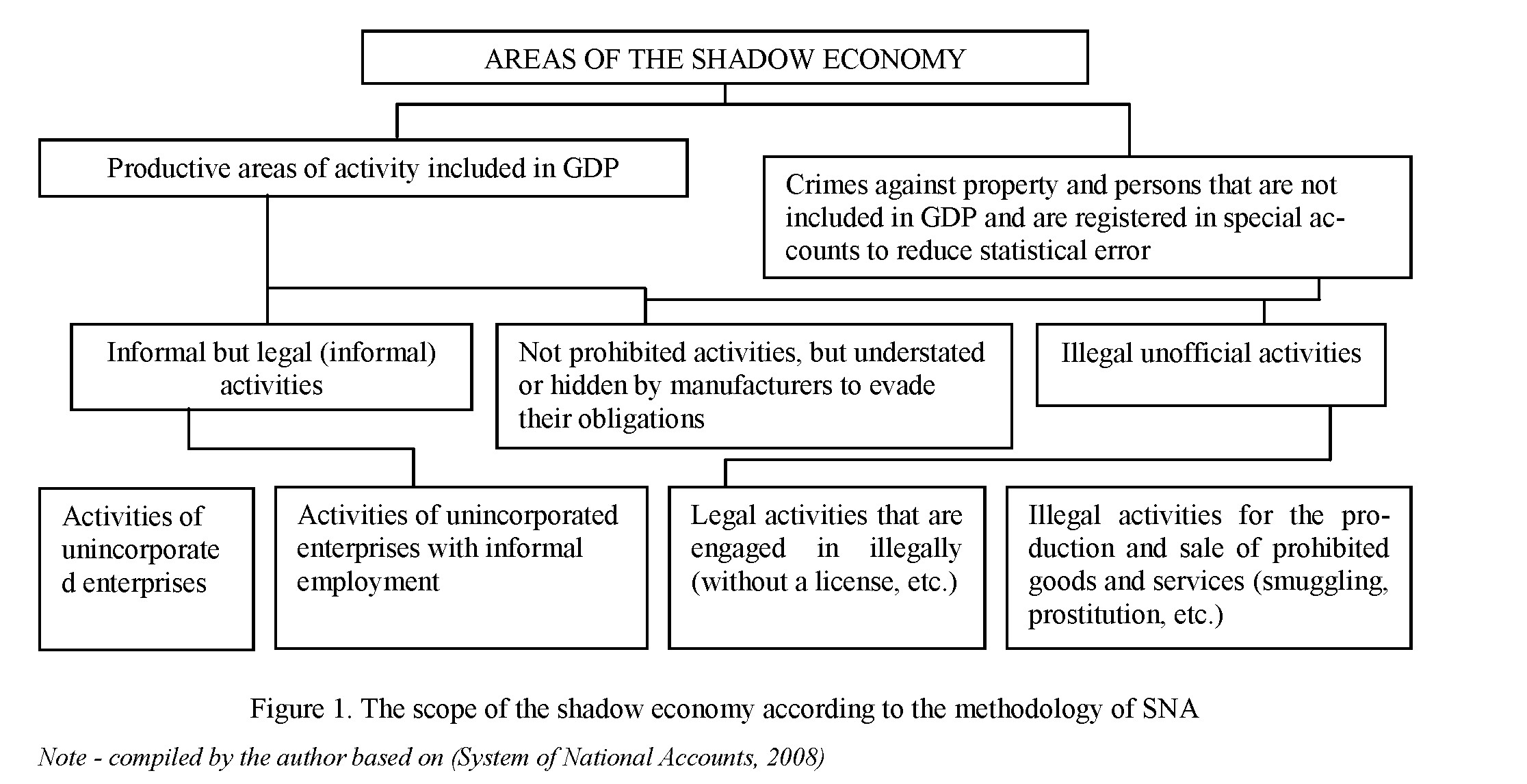

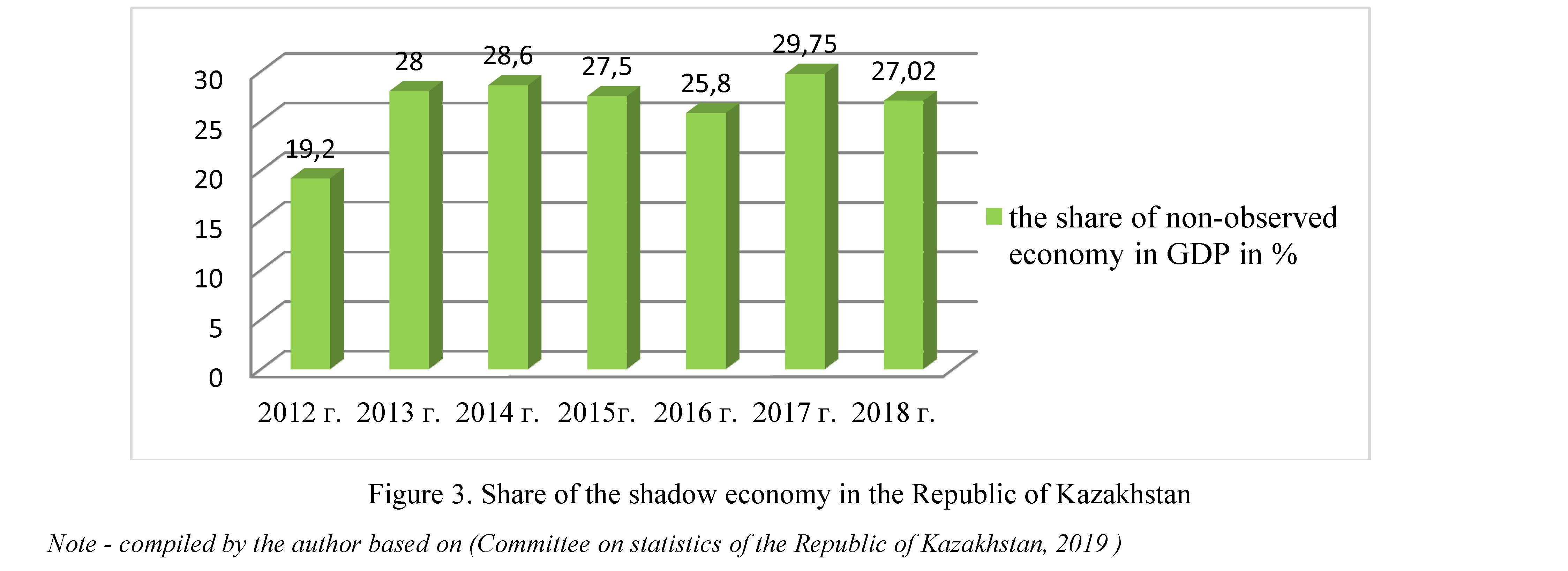
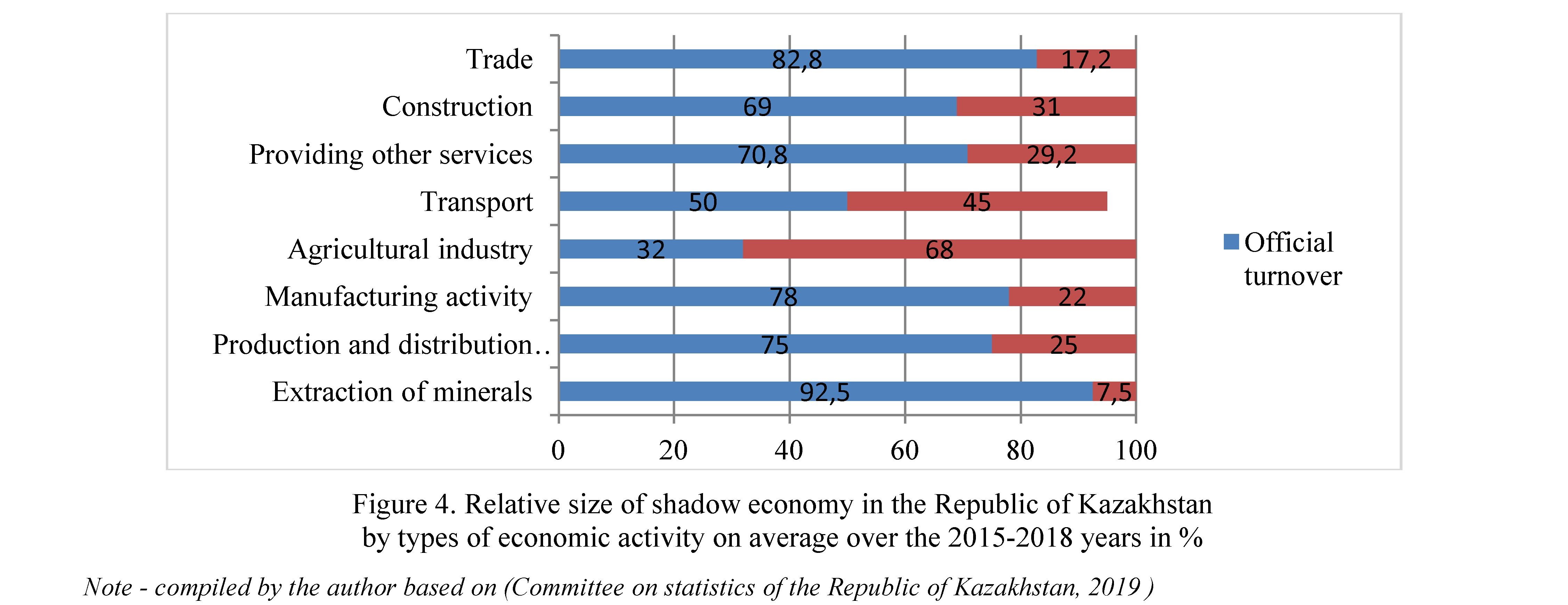

From figure 3 it is seen that the share of shadow economy is reduced. So, if in 2014 the share of nonobserved economy was 28.6% of GDP, in 2018, there was a decline of 1.58 %, which amounted to 27.02% of GDP. The average specific weight of the non-observed economy for the last six years was 26.5%, the size is in the range from 19.2 to 27.02% of GDP.
Dynamics of development of non-observed economic activities can be represented in the form of a branch cut, which is most attractive for "shadow" (figure 4).
From figure 4 it is seen that "shadow" entities choose mostly non-productive sector of the economy except agriculture. From 2013 to 2018, the share of the shadow economy in the production of commodities fell by almost half, from 9% to the current 6.9 percent (Figure 5).
In a service economy, an increasing volume of services away from an official Declaration, the share of the shadow economy over the same period rose from 19% to 20.12%. The most actively go into the shadows of the commercial enterprise.
In the sector of wholesale and retail trade (including car repairs) in 2018 the order of 8.62% of the facilities were without proper official registration. A year earlier this share was estimated lower - at the level of 8.87%. (Figure 6).
From figure 6 it can be seen that the reduction of the shadow economy is observed in the transport and logistics industry, from 4.1 % to 4.0%. Producers of agricultural products, as well, actively legalized. For the analyzed period the share of underground production in total production decreased from 2.47% to 2.37%. In the sector of real estate transactions, the share of the unobserved economy has decreased from 1% to 0.86%.
High level of shadow economic activity belongs to the construction industry and the provision of services. However, these sectors in the structure of the shadow economy have a low share. A significant share in the structure of non-observed economy has industries related to agriculture, however, the volumes in this sector remain at a low level (figure 7).
From figure 7 it is seen that the average level of the shadow by industry to GDP over 2015-2018 is different. The average level of the shadow by industry to the GDP attributed to agriculture, which amounted to
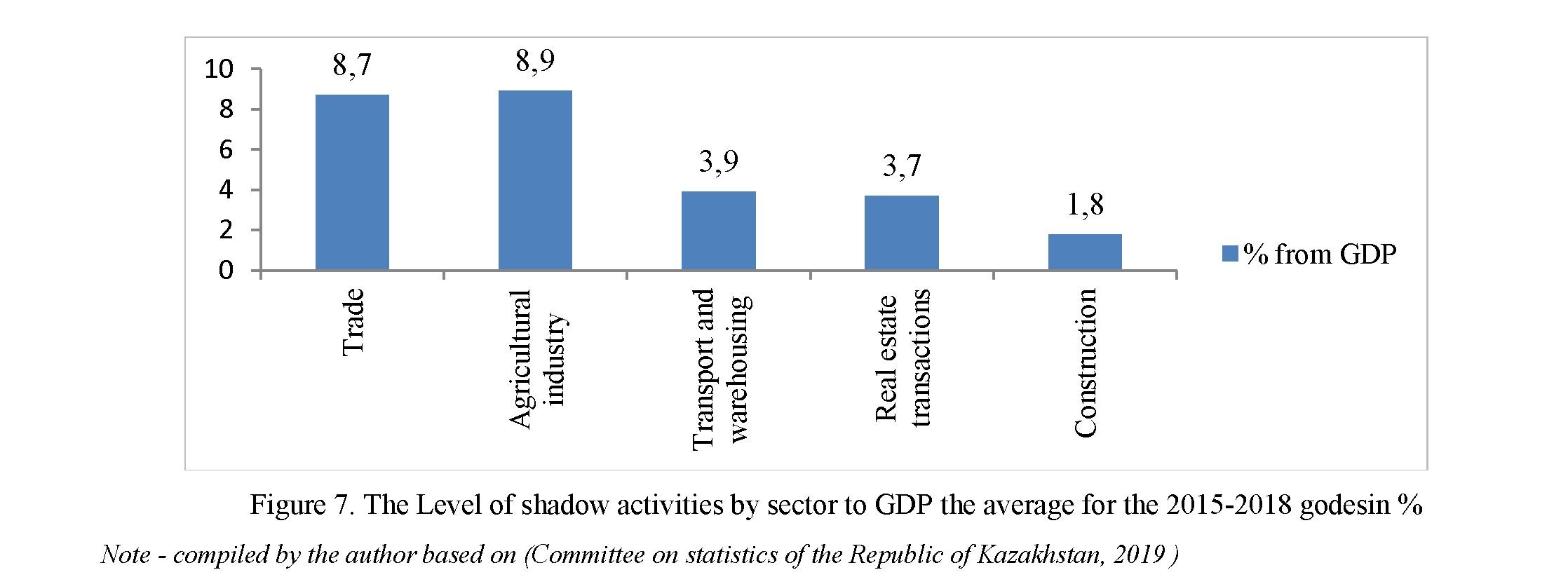
8.9% of GDP. The main form of manifestation of the shadow economy in agriculture is informal production. The greatest volume of shadow economy is concentrated on private farms (statistically important: this refers to farms of values, not a home for personal use), since they recorded a significant turnover of shadow money and informal employment. Prerequisites for the preservation of the informal sector in the agricultural sector is small commodity production, the lack of a developed logistics system for procurement, transportation and storage of raw materials. All these factors lead to the emergence in the sphere of a large number of economic agents, unreasonably overestimating the cost of production.
The shadow economy in the trade represented a hidden production with the aim of understating the tax base, spontaneous trade and lack of organization outlets, as well as informal employment.
This cross-sector division of underground activities shows perfection of normative-legal laws regulating various aspects of economic activity. This motivates us to transform an official of economic activity in the most "convenient" types of shadow activity.
Thus, the shadow processes are clearly expressed in the economy of the Republic of Kazakhstan, especially in the field of construction, agriculture, trade and transport. One of the priorities of the Government of the Republic of Kazakhstan is to reduce the share of shadow business in the economy and its translation to "legal" mode of operation. Therefore, not only for one region but for the state as a whole, the problem of development of the shadow economy, regulation of the shadow economy, necessary task. Implemented in the country measures aimed at democratization of society, business support, combating corruption and the shadow economy contribute to positive change in institutional and economic environment.
The effective combating of the shadow economy is largely dependent on understanding the place and role of the state in a market economy. For example, all agree that shadow operations have become subjects of market economy is simply uneconomical.
In recent times stands out approach to solving the problems of the shadow economy.
The first liberal ideas accompanied by full legalization of all of the shadow economy and the associated high rate of primitive capital accumulation.
The second approach, which arose on the basis of negative outcomes of the liberal and repressive. It is aimed at the expansion and strengthening of law enforcement authorities, improvement of interaction of special services, the increased penalties and stricter laws.
Undoubtedly, the state has direct responsibility in terms of combating corruption of the state apparatus and its fusion with the powerful business representatives. Necessary as the adoption of legal rules that minimise the possibility of extortion and bribery in relations between officials and business, and a strict administrative action against their specific manifestations.
The increasing resistance to existing norms and economic regulations that is reflected in the continuing importance of the shadow economy can be dealt with through a two-pillar strategy of reducing the attractiveness of the exit option (the shadow economy) whilestrengthening the voice option (voting and participation). (Table 1).
Table 1. A two-pillar strategy for reducing the attractiveness of the existing option (shadow economy) and strengthening the voice option
|
Exit option |
Voice option |
|
Reducing financial incentives to escape into the shadow economy Improve and simplify the tax system to strengthen acceptance Reform social security systems by strengthening the equivalence principle (more social tax contributions equals higher payments) Boost efficiency in administration and combat corruption Focus on higher growth and welfare in the official sector to reduce pressure on government budgets Protect property rights and increase investment in infrastructure Allow more flexible work arrangements for employees and employers (individual agreements) Reduce regulation and bureaucracy |
Strengthening popular participation in government Build trust and invest in social capital (for example, through support ofcorporate social responsibility) Reduce centralization Support more direct democratic elements in some areas Encourage popular participation to increase commitment and loyalty and reduce free riding Avoid attacking the symptoms through stricter controls, which encourages hiding participation in the shadow economy rather than reducing it Focus on reforms of institutions and systems Explain and communicate broadly the need for reforms |
|
Note - compiled by the author based on (Enste, D. H., 2018) |
|
Federal elements have to be strengthened, and instruments of direct democracy, such as referendums and legal initiatives, should be introduced to give citizens more opportunities to participate in rule making and the design of the tax system. Increased participation will diminish the perception of being subjected to unfair restrictions on personal freedom, thereby boosting tax morale and civic loyalty and reducing the attractiveness of the shadow economy. Acting in accordance with the subsidiarity principle (matters should be handled at the lowest competent level of administration) is economically advisable and more efficient (Enste, D.H., 2018).
To strengthen the material base and improvement of methods of fight against economic crimes and corruption in the United States, Japan, France, was created in 1989 (FATF) special international structure to combat money laundering. An account of major financial transactions and entities that have carried out this operation, financial and credit institutions. Was established financial intelligence agencies to track suspicious transactions and deposits. Banks are required to inform the security services about suspicious transactions and to provide access of these services to the clients ' accounts. Administrative processes are decentralized. To expand the administrative capacity of local authorities, they have been given responsibility, the extent of which varied depending on the Ministry and sector. Employment is determined by educational level. Admission to higher levels of service dependent on educational attainment and is often associated with exams.
One method of reducing the shadow economy has become a state policy of legalization. The legalization of criminal proceeds is a link between an open economy and the criminal sector of the shadow economy. Figure 8 presents the scheme of interaction of an open economy with the criminal sector, while the laundering of proceeds allocated conditionally to show its place in the functioning of the economic system.
Under the legalization of income obtained by criminal means is understood as giving lawful appearance to possession, use and disposal of monetary funds or other property obtained through the Commission of crimes.
The basic rules of combating laundering of the proceeds from uncontrolled economic activities are:
- the definition of the concept of legalization of income as activities of giving a legitimate appearance to the proceeds of crime;
- establishing requirements for the registration of a number of types of financial transactions and identification of persons who committed them, as well as requirements for storage of these materials;
- the use of the term "financial transactions" (which covers transactions with money, securities, property, property rights) and license and registration of such operations;
g) application of the concept of "organizations which perform financial operations." As such, should be recognized not only credit institutions but also all other business entities, as well as offices, gaming establishments, etc.;
- restriction of commercial and banking secrecy in order to obtain information necessary to detect and prevent action on legalization of proceeds from crime;
- the imposition of restrictions on financial transactions with the cash movement of cash across the customs border;
- the introduction of the category of financial transactions subject to special control;
- obligation of employees of organizations carrying out financial transactions, to inform the competent authority about the illegal transactions and transactions requiring special control;
I) the immunity of employees of organizations carrying out financial transactions, accountable for the disclosure of information constituting commercial or Bank secret, if this information to the shadow economy to the authorized body about the illegal transactions and transactions requiring special control;
k) establishment of responsibility of employees of organizations carrying out financial transactions.
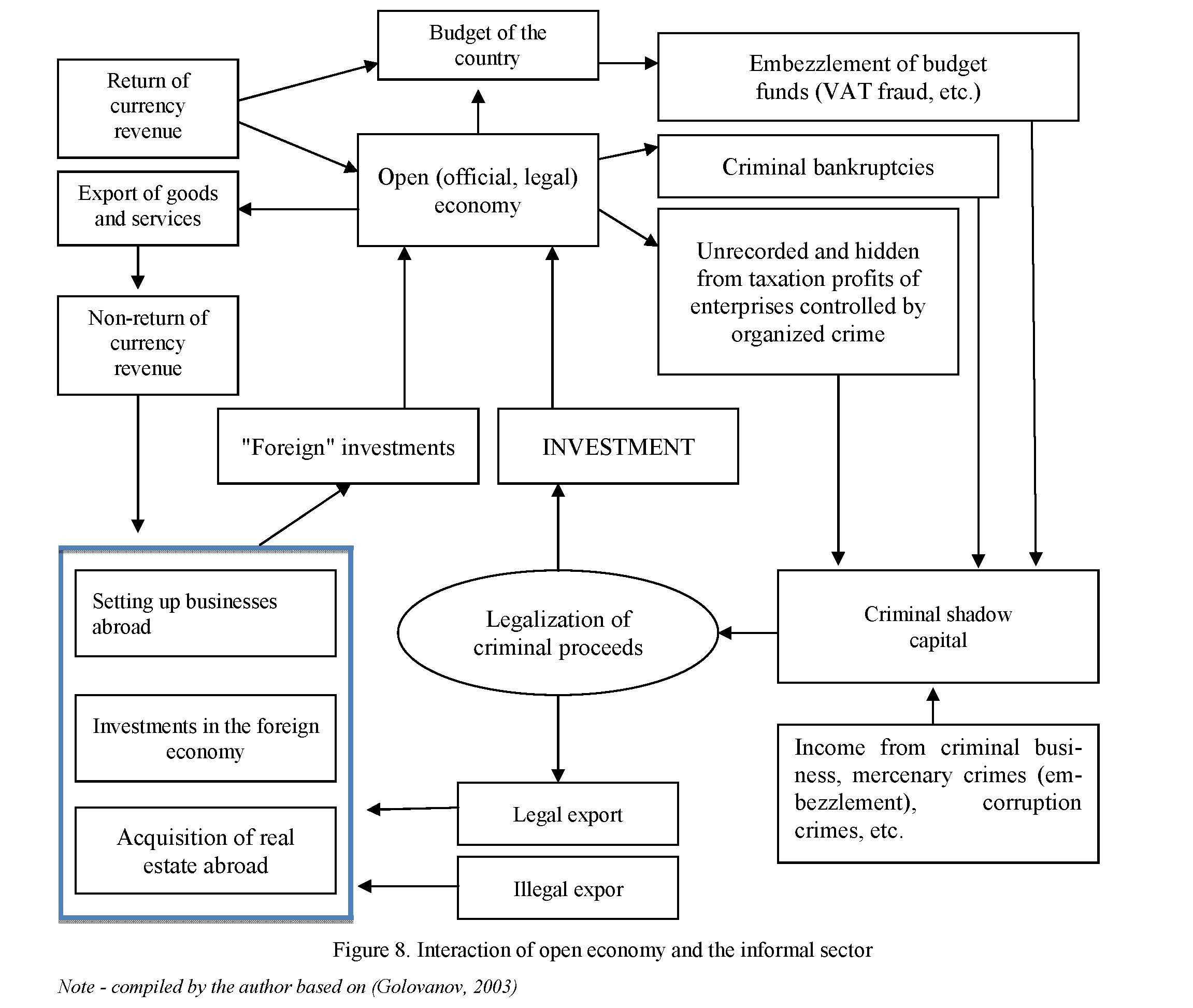
61
Thus, such events allow to use a significant portion created in the society rents on the implementation of socio-economic programs, the development of fundamental scientific research and for the development of small business. It is fundamentally important to provide control not only of regions but of the state over activity of shadow structures operating in the strategically important for the economy enterprises. This is essential to reduce the effect of shadow structures on the economy as a whole.
Conclusion
Economic theory still has not developed a universal definition of the shadow economy, and the reason lies in the conceptual disagreement of authors and special approach to it in different countries. This fact reflects significant theoretical and methodological problem due to the fact that the term "shadow economy" in the modern period is widely distributed, including is subject to state control.
Shadow activity in sectors of the Kazakh economy appears uneven. Leaders among the "shadow" sectors of the economy are: agriculture, manufacturing, construction and transportation. The minimum value of the shadow activities have on mining (7%), production and distribution of oil, gas and water (up to 21%). This is because these industries are fully controlled by the government.
The decrease in the level of incomes and a sharp differentiation has led to the growth of the shadow activities of the population. This is especially clearly seen in agriculture and transport, as tax administration data sectors of the economy difficult.
The legalization of shadow money is a necessary condition for the functioning of organized crime in the economic sphere. In order that the money or other property derived from criminal business could be put into further circulation without danger for the criminals to be exposed, legal cover mst be purchased, which is achieved in various ways. The fight against laundering of criminal money is one of the most effective mechanisms for combating criminal economic system, causing significant damage to a healthy economy and undermining the financial stability of any state. After all, shadow capital legalized allows organized crime to buy all types of property and to establish control over the economic and then the political system of the country.
References
- Bugubayeva R.O., K.S. Ainabek, N.I. Vidritskaya & B. U. Seitkhozhin (2018). Economicheskay bezopanost´ i problemy ее obespechenia v Respublike Kazakhstan [Economic security and the problems of its maintenance in the Republic of Kazakhstan].Almaty: SSK
- Committee on statistics of the Republic of Kazakhstan (2019). Statistics Division «Kazakhstan for 2018». Retrieved from http://state.gove.kz
- Daribekov S.S. (2007), Nekotorye aspekty tenevoy ecQnQmiki [Some aspects of the shadow economy]. Vestnik Karagandinskogo Gosedarstvennogo Universiteta. [Preschool Education Today].2(46), 4-9
- Enste D.H. (2010), Regulation and shadow economy: Empirical evidence for 25 OECD-countries, Constitutional Political Economy, 21(3), 231-248
- Enste D.H. (2018), The shadow economy in industrial countries. IZA World of Labor 2018: 127 doi: 10.15185/izawol.127.v2
- Fisher Liz (2017 September 1). Time to Shrink Shadow Economy. ACCA Think Ahead. Retrieved from http://www.accaglobal.com/pk/en/member/discover/cpdarticles/business-management/shadoweconomy-cpd.html
- Golovko M.V. (2013) K voprosy o sposobakh ochenki determinantov tenevoy economiky [To the question of how to assess the determinants of the shadow economy]. Nationalnye interesy prioritety i bezopasnost´. [Preschool Education Today].33, 36-43
- Guskova A.V. (2017) Parallelnay economika: serfing po pyti tenevym sectoram [Parallel economy: surfing in five shadow sectors].Vestnik Nizhegorodskoy akademii MVD Rossii. [Preschool Education Today]. 3, 296-299
- Golovanov N. (2003) Tenevay economika i legalizachiy prestupnykh dokhodov [The shadow economy and the legalization of criminal proceeds]. St. Petersburg: Piter
- Hope K. R. (2014), Informal economic activity in Kenya: benefits and drawbacks, African Geographical Review, 33(1), 67–80.
- Kopylenko O., I. Gryshova, O. Diachenko (2018) Leading institutional mechanism of the state regulation and the shadow economy. Advances in Social Science, Education and Humanities Research, 2nd International Conference on Social, economic, and academic leadership (ICSEAL 2018), 217, 60-68. https://doi.org/10.2991/icseal-18.2018.10
- Message from the first President of the Republic of Kazakhstan N. Nazarbayev to the people of Kazakhstan. New development opportunities in the conditions of the fourth industrial revolution // Kazakhstanskaya Pravda. - 2018, January - 11.
- Remeikiene R. , L. Gaspareniene, F. G. Schneider (2018), The definition of digital shadow economy Technological and Economic Development of Economy, 24(2), 696-717
- Ryabushkin B.T., Churilova E.Yu. (2003) Metody ochenki tenevogo i neformalnogo sektorov economiki [Methods for evaluating the shadow and informal sectors of the economy]. Moscow: Finance and credit
- System of National Accounts (2008). The United Nations Statistics Division. Retrieved from http://unstats.un.org/unsd/nationalaccount/docs/SNA2008.pdf.
- Schneider F., Buehn A. (2018), Shadow Economy: Estimation Methods, Problems, Results and Open questions, Open Economics, 1, 1–29
- Schneider, F. (2016). Estimating the Size of the Shadow Economies of Highly-developed Countries: Selected New Results, CESifo DICE Report, 4, 44-53
- Smith, P. (1994), Assessing the Size of the Underground Economy: The Canadian Statistical Pespectives Canadian Economic Observer, 11-010, 16-33.